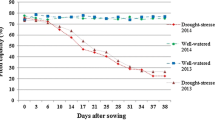Abstract
Wild lentils are a potentially important source of genetic variation for the improvement of the cultivated lentil. A lack of evaluation data for characters of economic importance is one constraint to their use in breeding programmes. Here, variation in selected phenological and agro-morphological characters in 310 accessions of wild lentils is reported. This includes 153 accessions of Lens culinaris subsp. orientalis, 33 accessions of L. odemensis, 32 accessions of L. nigricans, 90 accessions of L. ervoides and 2 accessions of L. lamottei. Certain L. culinaris subsp. orientalis accessions had substantially more leaves per plant, peduncles per plant, pods per plant and seeds per plant, and greater leaf area than two cultivated lentil checks. The total biomass obtained from the best L. culinaris subsp. orientalis accessions was comparable with the checks. The harvest index of one check was comparable with that of the two best L. culinaris subsp. orientalis accessions. Of the wild taxa, the L. lamottei had the highest average 100-seed weight. Broad-sense heritabilities were calculated and found to be high for days to average flowering and days to average podding. Significant correlations exist between quantitative characters and latitude of origin. Phenological adaptation, through sensitivity to photoperiod, temperature or both, appear to be a major evolutionary force in wild lentils. Variation is mapped according to geographical origin of accessions in order to identify geographical patterns or clines of variation. Accessions of L. culinaris subsp. orientalis from Uzbekistan, Turkmenistan and Tajikistan had among the largest biomass, the most peduncles per plant and many pods and seeds per plant. One-hundred seed weight, however, did not decline as expected with increased seed number.
Similar content being viewed by others
References
Ahmad, M., A.G. hautrier. D.L, MeNeil, D.J. Burritt & G.D. Hill, 1995. Attempts tn overcome postfertilisltion barrier in interspecific crosses of the genus Lens. Plant Breed. 114: 558–560.
Bayaa, B., W. Erskinc & A, Harndi, 1994. Response of wild lentil to Ascochyta fahac f.sp. tentis from Syria. Gen. Res. and Crop Evol. 41: 61–65.
Bayaa, B., W. Erskine & A. Hamdi, 1995. Evaluation of a wild lentil collection lor resistance to vascular wilt. Gen. Res. and Crop Evol. 42:231–235.
Czefranova, Z. 1971. Review of species in the genus Lens Mill, (in Russian). Nov. Sistemat Vysshikh Rastenii 8: 184–191.
Erskine, W., Y. Adham & L. Holly, 1989. Geographical distribution of quantitative traits in a world lentil collection. Euphytica 43: 97–103.
Erskine, W., R.H. Ellis, R.J. Summcrfield, E.H. Roberts & A. Hussain, 1990. Cliaracterisatinn of responses to temperature and photoperiod lor time to flowering in a world lentil collection, Theor. Appl. Genet. 80: 193–199
Erskinc, W. & W.J. Goodrich, 1991. Variability in lentil growth habit. Crop Sci. 31: 1040–1044.
Erskine, W. & M. C. Saxena, 1993. Problems and prospects of stress resistance breeding in lentil. In: K.B. Singh & M,C. Saxcna (Eds), Breeding for Stress Tolerance in Cool-season Food Legumes, pp. 3 5 9 –372, John Wiley & Sons, Chichester, UK.
Ferguson, M.E. & L.D. Robenson, 1996. Genetic diversity and taxonomie relationships within the Genus Lens as revealed by allo/yme polyinorphism. Euphytica 91: 163–172.
Ferguson, M.F.,, B.V. Ford-Lloyd, L.D. Rohertson, N. Maxted & H.J. Newbury, 1998. Mapping the geographical distribution of genetic variation in ltie genus Lens lor tlie enhanced conservation of plant genetic diversity. Mol Ecol (in press).
Gosheii, D., G. Ladizinsky & F.J. Muchibauer, 1982. Restoration of mciotic regularity and fertility among derivatives of Lens culinris x L. nigricans hybrids. Eliphytica 31: 795–799.
Hamdi, A. & W. Ersitine, 1996. Reaction of wild species of the genus Lens lo droughl Euphytica 91; 173–179.
Hamdi, A,, I. Ktisnieiioglu & W. Erskine, 1996. Sources of winter hardiness in wild lentil. Gene, Res. Crop Evol 43: 63–67.
ICARDA, 1991. Legume Program: Annual Report for 1991. ICARDA. Aleppo, Syria.
Ladizinsky, G., 1979. The origin of lenti and its wild genepool. Euphytica 28:179–187.
Ladizinsky, G., 1993. Wild lentils. Crit. Rev. in Plant Sci. 12: 169–184.
Ladizinsky, G., 1997. A new species of Lens from south-east Turkey. Bot. J Lin. Sue. 123: 257–260.
Ladizinsky, G. & S. Abbo, 1993 a. Cryptic specialion in L. culinaris. Gen. Rcs. Crop. Evol. 40: 1–5.
Ladizinsky, G. & S. Abbo, 1993b. Wild lentils of central Asia. FAO/IBPGR Plant Genetic Resources Newsletter 93: 5–8.
Ladizinsky, G., D. Braun, U. Goshen & K Muehibauer, 1984. The biological species of the genus Lens. Bot, Gaz. 145: 253–261.
Ladizinsky, G., D. Braun & F.J. Muehibaucr, 1983. Hviticnce for the domestication of Lens nigricansi (M. Bitib.) Godron iu S. Europe. Bol. J, Lin. Soc. 87: 169–176.
Muehibauer, F.J., 1993. Use ofwild species as a source ofresistance in cool-season food legume crops. In: K.B. Snigh & M.C. Saxena (Eds), Breeding for Stress Tolerance in Cool-season Food Legumes, pp. 359–372, John Wilcy & Sons, Chichester, UK.
SAS Institute Inc., 1989. SAS/STAT User's Guide, Version 6. Fourth Edition. Gary, North Carolina, USA.
SPSS Inc., 1995. SPSS for Windows, Release 7.0. Chicago, USA.
Strategic Mapping Inc., 1991. Alias Mapmaker, Golden Software, Golden, Colorado, USA.
Summerlicid, R.L, E.H. Roberts, W. Erskine & R.H. FJlis, 1985. Bffects of temperature and photoperiod on flowering in lentils Lens culinaris Medic. Ann. Bol. 56: 659–671.
Van Oss, II., Y. Aron & G. Ladizinsky, 1997. Chloroplast DNA variation and evolution in the genus Lens Mill. Theor. Appl. Genet. 94– 452–57
Author information
Authors and Affiliations
Rights and permissions
About this article
Cite this article
Ferguson, M.E., Robertson, L.D. Morphological and phenological variation in the wild relatives of lentil. Genetic Resources and Crop Evolution 46, 3–12 (1999). https://doi.org/10.1023/A:1008645029658
Issue Date:
DOI: https://doi.org/10.1023/A:1008645029658




